RSA Debate
Round 1, Part 2b
DEATH STAR FIREPOWER
<snipes snipped> Your basic claim is that the Death Star induces an exothermal chain reaction of unknown properties in Alderaan, rather than simply transferring a huge amount of power into it and destroying it. This strikes most people as absurd; after all, the opening crawl of ANH states quite clearly that the Death Star is "an armored space station with enough POWER to destroy an entire planet" <snip>
If the quote had stated "firepower", there might be a worthwhile argument to make based on the opening crawl. As it stands, however, there is not. The Superlaser Effect also grants the Death Star the power to destroy an entire planet . . . merely in a different way.
The word "power" is used not only to refer to raw firepower, but also to capability. For instance, one man has the power to kill another. Does this imply that he has some weapon hidden away near the appendix which can direct raw energy toward another person? No. It implies ability. Vader also uses the term in this way: "The power to destroy a planet is insignificant next to the power of the Force."
I trust you realize that Vader was not claiming that the Force would allow him to destroy entire solar systems, or entire galaxies, merely by thinking about it. He referred to the capabilities it offerred . . . precognition and so on . . . which could allow control in a way that fear of the Death Star could not.
In any case, you claim to have conclusive evidence that the opening crawl of the canon movie is wrong. According to you, the superlaser strikes Alderaan (and you deny the existence of its shield) but damages very little of the planet <snip>
Substantially accurate, so far.
Instead of heating the planet or directly causing it to expand, you claim that the superlaser creates an "anti-Genesis effect" which moves over the surface of the planet, spreading outward from the point of contact until it eventually covers the entire surface <snip>
Still substantially accurate.
The "anti-Genesis" effect you refer to is evident by the band which encircles the globe, meeting itself on the far side at a moment coinciding with the secondary blast, which occurs after the superlaser beam has ceased.
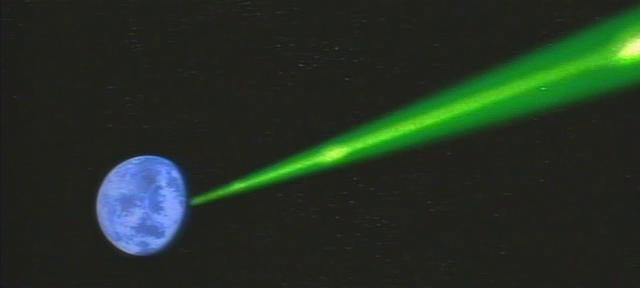
Frame 0
Just before the superlaser makes contact. Note well the white (or, more correctly, brighter blue) cloud pattern which the superlaser beam is about to make contact with.
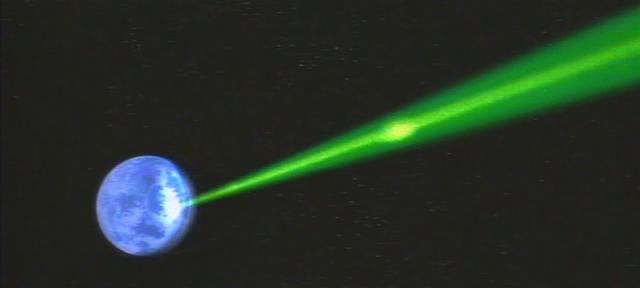
Frame 1
According to you: "The white flash of the superlaser strike." Yes,
there's a white flash, but you neglect to mention the "halo
effect" outside the atmosphere on the right-hand side,
I neglect to mention a halo effect outside the atmosphere because there is no evidence for it being outside the atmosphere. If one assumes that all planets are approximately spherical, one might notice that Alderaan does not appear to be spherical in your Cap 0. That is because we are seeing part of Alderaan's night side on the right side of the planet, past the terminator.
To illuminate this point, I have drawn a circle over Alderaan, using part of your AlderaanBlast-1.jpg screen capture.
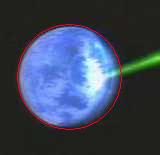
http://ocean.otr.usm.edu/~randers2/AlderaanBlast-1rsa1.JPG
The circle is 103 pixels tall, and 103 pixels wide. You'll note that the entire planet, plus your halo effect, are contained within the circle, with room to spare.
Contrary to your interpretation, I see no reason to assume that the halo is extra-atmospheric. It would appear to be caused by atmospheric scattering from a bright light source (i.e. the superlaser point of impact).
and the unaffected oceans and clouds underneath
Indeed, this constitutes a severe problem for your Direct Energy Transfer (DET) theory.
Without any evidence for a planetary shield, one must assume that the planet was laid bare for the superlaser hit. If that is so, then an energy beam with your calculated energy of 1e38J should have produced severe atmospheric disruption, including but not limited to cloud burn-off, profound ionization effects, and so on.
In a prior calculation, I have estimated the energy density per unit volume of a 5 kilometer diameter superlaser beam traveling through the troposphere.
The troposphere is the lower 12 kilometers of atmosphere (the rough limit of cloud-tops on Earth, because the stratosphere above is far drier). Assuming that a mere 3.5e24J of energy (about 1/28,570,000,000,000th, or 1/28-trillionth, of your 1e38J figure) would be absorbed evenly throughout that volume of atmosphere (235.6km^3), we have an energy density per volume of 14.6e12J/m^3.
That's almost 3.5 kilotons of TNT per cubic meter of Earth-like tropospheric atmosphere. Given that the density at sea level is about four times what it is at the top of the troposphere, it would be a "mere" .9 kilotons or so per cubic meter at the likely height of the thick Alderaan cloud-tops.
Some . . . and now, evidently, yourself included . . . have argued that a planetary shield is the explanation. In a way, you are correct . . . it is the only explanation that can possibly explain the situation.
However, the attempted explanation does not work in light of the canon facts. When the Death Star II fired on and destroyed Rebel starships, the hulls of those vessels did not show the sort of bright-white illumination Alderaan shows until actual impact of the superlaser against the ships' hulls occurred.
(The following screencaps were created from a vidcap, DSCalamari.mpg, graciously provided by Phil Skayhan.)
Rebel Starship #1: The Liberty
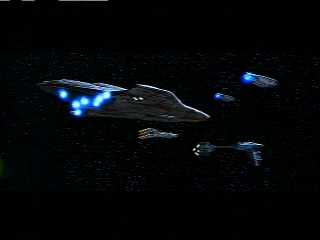
http://ocean.otr.usm.edu/~randers2/DSCalamari105.jpg
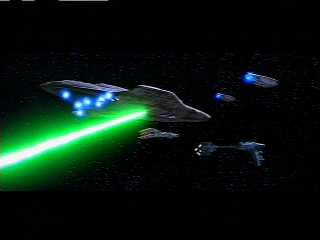
http://ocean.otr.usm.edu/~randers2/DSCalamari111.jpg
In the second image, the superlaser is one frame away from hitting the hull. There is an unusual delay of the superlaser beam . . . half of what can be seen here appears in one frame (106), takes several additional frames to travel a short distance, then it finally impacts at Frame 112. If the Liberty was shielded, this slowing of the superlaser beam is the only observable effect, with the possible exception of a small green streamer in front of the superlaser beam in frame 107.
But, I digress. As you can see (by comparison to 105, if needed) there is no apparent extra light illuminating the hull in frame 111.
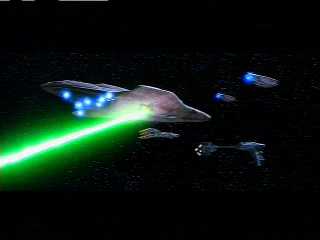
http://ocean.otr.usm.edu/~randers2/DSCalamari112.jpg
In frame 112, impact has occurred. The hull is beginning the explosion which will continue from the exact same point in frame 113, and which will result in the total destruction of the ship. As you can see, a flare of light is finally appearing over the hull, now that destruction is beginning.
Rebel Starship #2: Unknown Wingless
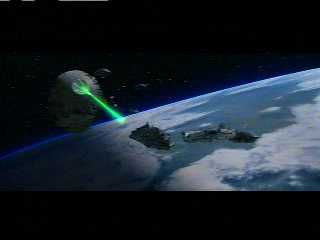
http://ocean.otr.usm.edu/~randers2/DSCalamari227.jpg
Again, the superlaser one frame before impact. There is no peculiar slowing of the beam on this occasion. The Rebel starship is apparently illuminated only by the sun in frame 227.
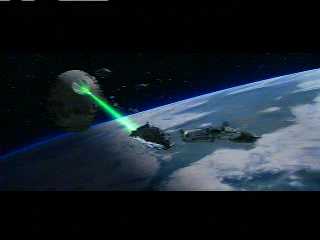
http://ocean.otr.usm.edu/~randers2/DSCalamari228.jpg
Impact. The underbelly of the vessel is now brighter than the planetary clouds beneath, suggesting a hit in the aft ventral region. By the next frame, the ship's outline is still visible, but the vessel is engulfed . . . but we'll come back to that one later.
If we are to assume that the Death Star was firing lower-energy shots (which presumably follows from the beams' similar intensity to the Alderaan shot, but with a much smaller beam diameter), it may have been possible for the starship shields to resist for an instant. In any case, this is not seen . . . what is seen is that there is no flash or other evidence of superlaser-shield interaction.
Translate back to Alderaan, and the extreme brightness at the targeted area can only be explained as a direct hit to the solid surface. Since no atmospheric effects are observed, we must assume that the atmospherically-absorbed DET was far, far, far less than 3.5e24J, 1/28-trillionth of the 1e38J figure.
How much less? Well, even if we assumed that the atmosphere was pure liquid water near the freeze point and at normal sea-level conditions, simply to avoid raising the entire 235.6km^3 volume (a mass of 235,600,000,000,000,000g) 100 degrees Celsius would require that the DET superlaser deposit no more than 98,575,040 TJ into the atmosphere. That is simply to avoid vaporization of the near-freezing water. Converting from terajoules, that is no more than 23.5 gigatons.
Naturally, clouds contain much less than that amount of water. A rough estimate from perusing online suggests that the droplets of clouds are in the micron range, and that these have a density of around 100 per cm^3. Ice crystals in clouds would be of similar proportions. "Bulk" water will require far more energy to vaporize than this vapor.
In short, DET requires the planetary shield, and badly. However, without canon evidence for a planetary shield, and canon evidence against one working and looking the way it is required by DET for it to look, DET fails.
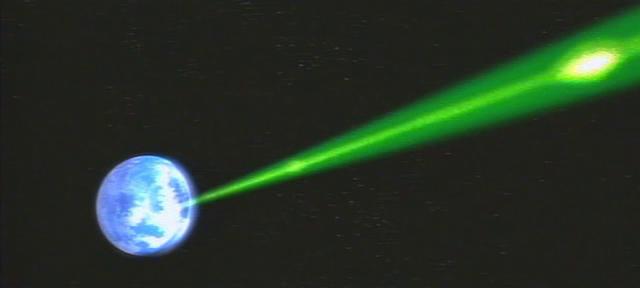
Frame 2
<snip> The halo effect is probably a visible manifestation of the planetary
shield's reradiation mechanism.
Or simple atmospheric refraction of such incredible brightness occurring at a point on or near the surface where the superlaser hits. Note that we can now see a continuation of the cloud pattern where the superlaser hits, extending past the terminator to the lower right. However, note also that the ground below is still semi-shaded, in keeping with the terminator.
This also suggests a simple atmospheric effect, since a point-source of extreme brightness at or very near the surface would directly light up the distant clouds, but could not be expected to directly light the planet's surface over the horizon from the point-source.
According to you: "The firey explosion begins, mostly near the beam."
Incorrect. I do not make that comment in reference to the frame (Frame 2) you have provided. Instead, your quote applies to the fourth frame. http://ocean.otr.usm.edu/~randers2/STSWdeathstar2.html
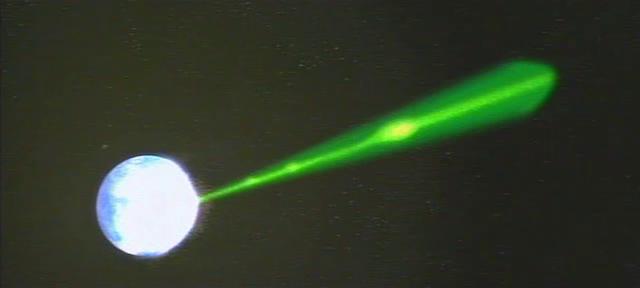
Frame 3
Dramatic intensification of halo effect, which is now so bright that it
saturates the video medium.
Unfortunately, there is no shield halo effect in play. However, the video medium is saturated . . . to the point that even the space around the planet exhibits an increase in brightness of several planetary diameters.
The "Superlaser Effect"-proper has now begun in earnest. In the next frame, we will see a more orange color, a characteristic of fire. Hence my comment about a firey explosion. The saturation of the medium will also reduce somewhat, manifesting as a temporarily-lessened 'glow' of the empty space around Alderaan.
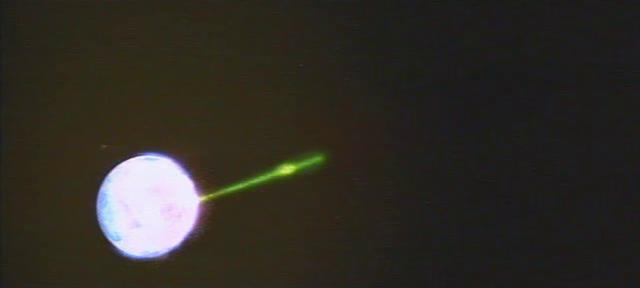
Frame 4
Slight change in the halo effect's physical appearance, although the
coverage area has not dramatically changed (note that the far side is
still blue). <snip>
Quite correct. Not only does the left side of the planet remain visibly unaffected (besides a possible brightness increase in the area) as I have made reference to previously, but the polar regions also do not appear to have disassembled at all.
This would imply that the superlaser is drilling into the planet's mass already, although the sheer scale means that there will be a measurable time lag before the surface expands (even at 5% of c, it would take 1 frame for a lower mantle expansion to breach the surface and 5 frames for a core expansion to breach the surface). Intensification without forward progress is consistent with a shield, but not with your mysterious surface-level chain reaction.
I disagree. Besides the fact that there is no evidence for a shield, there is also the problem for DET wherein shield failure should not provide for the exact same area to be affected as observed. If a shield had failed, and if the superlaser is indeed "drilling into the planet's mass already" using DET, the expansion perils you mention can only apply to DET, alone.
Why? Because the beam must be depositing its energy into a relatively small patch of planet, drilling its way down. Disastrous surface and atmospheric effects would be expected, of course, but the expansion you speak of is only necessary at this time with DET.
Meanwhile, the Superlaser Effect theory does not require core or inner/lower mantle effects or visible ejecta from those regions at this point. The crust, upper mantle, and mantle (a.k.a. transition region, down to 650km) are sufficient. Even if one were to argue that we needed to see parts of the mantle as visible ejecta, then at your suggested 5% lightspeed, this would be just barely over a frame at 24fps.
Note also that the approximate point of superlaser impact is now a much darker region. I believe this represents the coalescence of the band which will shortly begin to encircle the globe.
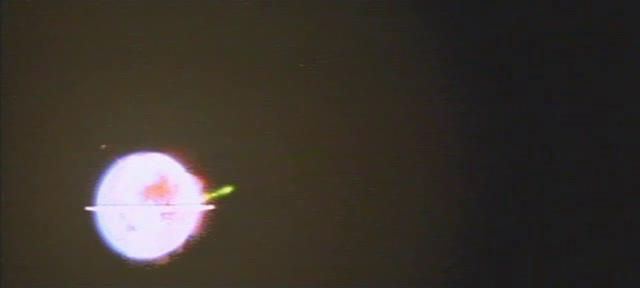
Frame 5
Planetary explosion begins outright.
More or less. The left side of the planet definitely remains unaffected, but it looks like the poles are not as cozy as they once were. However, it is hard to tell exactly.
The fire rings must have appeared somewhere between frames 4 and 5, and they are already 1500 km away from surface. Note that they are centred around the planet's core and aligned with the camera angle, not the superlaser.
Correct.
According to you: "The rings and a band of brightness around the center of the beam appear. The band will encircle the globe". What is this band, Darkstar? I don't see any "band"; at best, there are irregularities in the brightness, which are hardly inexplicable in a chaotic explosion.
Blank: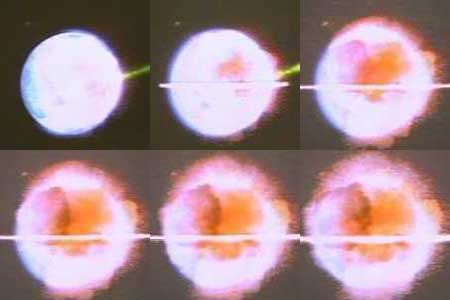
http://ocean.otr.usm.edu/~randers2/RSAband.jpg
Marked: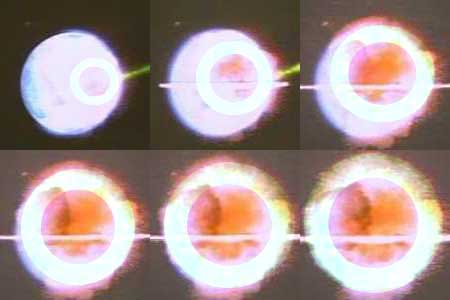 http://ocean.otr.usm.edu/~randers2/RSAband1.jpg
http://ocean.otr.usm.edu/~randers2/RSAband1.jpg
In the above two links, I have attempted, in spite of my utter lack of artistry, to roughly illustrate what I refer to as the globe-encircling band. It is easier to see if you advance the video at about one frame per second, but the bright band is there in any case. As you continue to look at the frames, pay attention to the fact that the surface remains substantially intact until the band passes.
You also say: "the first ring has appeared all the way around the planet, even though that left side (with atmosphere, even) still seems to be stable. (That's the last frame of the superlaser.) Assuming anyone was still alive at this point on the other side of the planet, they must've wondered what the hell was going on." In short, there is a blue tinge at the far side which you use as proof that the far side is completely unaffected.
No, not "completely unaffected" . . . just "stable". In other words, it isn't currently in the process of blowing to smithereens (though I can't imagine the stable surface areas were having a field day at this point). In any case, the surface appears to be holding. However, the area is significantly brighter than it previously was.
However, one should not read too much into a blue tinge, as we can see in the screenshot below:
Actually, one should not read too much into "stable".
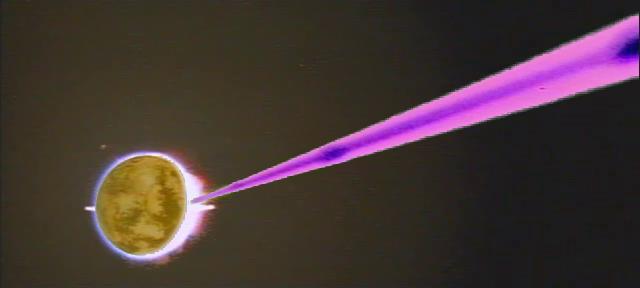
Frame 5 with frame 0 inverted and superimposed
We can see that the planet has already been heated up
to such an extent that glowing material has been hurled at least
100-200 km away from the surface at all points around the planet,
INCLUDING the far side. I doubt anyone would be lazily "wondering
what the hell was going on" when the ground beneath his feet has
been heated up to such an extent that it has shot up into the sky and
out of the atmosphere!
I have attempted, with questionable success, to replicate your inversion and superimposition technique. However, my abilities at copy-cat image inversion and superimposing are irrelevant. What is relevant is that I have applied the technique to AlderaanBlast-0.jpg and AlderaanBlast-2.jpg.
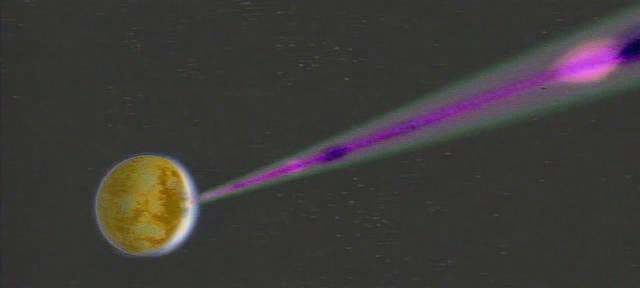
http://ocean.otr.usm.edu/~randers2/AlderaanBlast-0&2invert.jpg
As you can see, the same atmospheric brightening on the left is in play here, as is in play in your superimposing of Frame Five. Understandably, it is not to the same extent, but the white sliver of the effect is there.
You'll note that according to your argument, Frame Two represents a frame in which a shield is up. However, applying your Frame Five argument to Frame Two must also suggest that "the planet has already been heated to such an extent" that material, mysteriously glowing blue, is being hurled away from the left side of the planet, in spite of the shield, and in spite of the fact that all ejecta observed thus far is orange.
I submit that what we are seeing is atmosphere in both cases, especially given that the surface appears stable (i.e. blowing to smithereens not in progress).
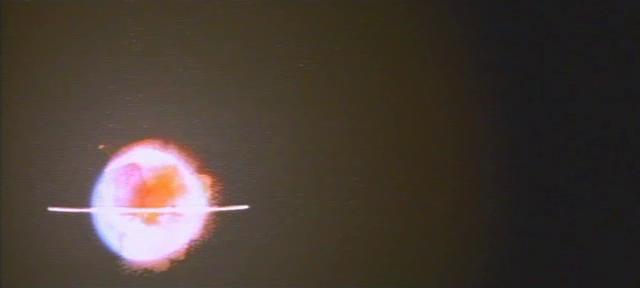
Frame 6
<snip>
The superlaser beam is no longer visible.
<snip>
And did you notice that the reddish, or "darkened" region is centred around the MIDDLE of the planet, and not the superlaser contact point as you claim, which was well to the right?
First, it should be noted that the reddish-orange region is closer to superlaser-center in Frame Five.
Second, A two-dimensional analysis might lead one to come to the conclusion that the reddish-orange area is horribly off-center. However:
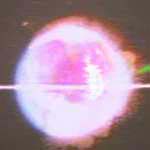
http://ocean.otr.usm.edu/~randers2/AlderaanBlast-6&1rsa.jpg
The above is a partial superimposing of Frame Six, the frame in question, and Frame One, the first frame to show the superlaser hitting the planet. You'll note that the cloud formation which the superlaser struck the central lower half of is positioned at the lower right of the reddish-orange area. Given the location and the curvature on the planetary sphere, some of the reddish-orange area further toward the right may be brightened by the band beyond (i.e. further to the right), as compared to the material we get to see dead-on. In any case, what little deviation there may be does not significantly affect the findings. Now to the DET attempt to explain the same:
<snip>
All I see is a planet which is rapidly expanding, albeit with a slight asymmetry that is easily explained by energy propagation delay through the planet's mass.
Why should there be an asymmetry of this type? I do not see how propagation delay would explain an explosion/expansion which, by your own statements, is leaning a little to the left of the superlaser impact point.
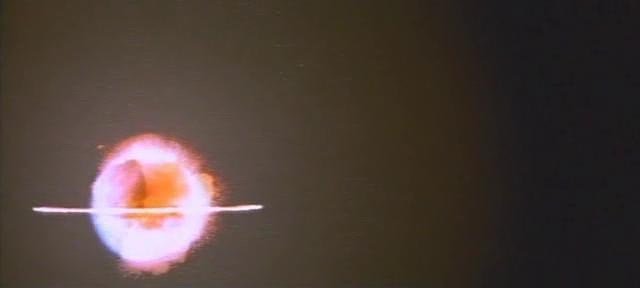
Frame 7
Note that the surface is still just visible on the lower left of the planet.
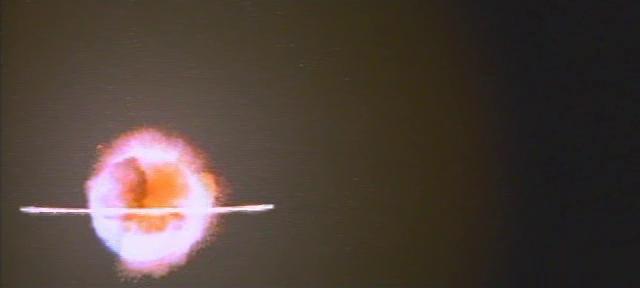
Frame 8
According to you: "A couple of frames later,
the band of brightness has expanded, as have the rings, and the dark patch where
the superlaser hit is darker."
"...as has the ring..."
Thank you for pointing out the grammar error, if even inadvertently. As I mention on the page, it is a cut-and-paste from ASVS with pics attached, and I've mentioned the severe need of an update.
Again, you seem to be inventing observations out of thin air. The dark patch is now well to the left,
Which, given that it is the material we are seeing
dead-on, makes sense.
<snip>
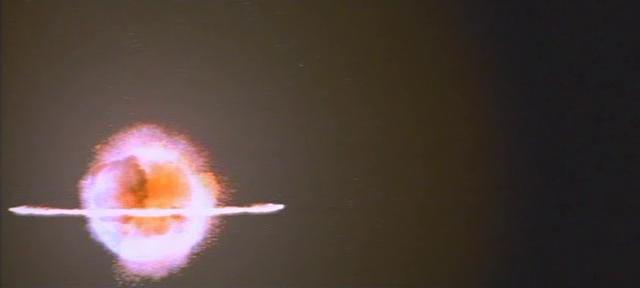
Frame 9
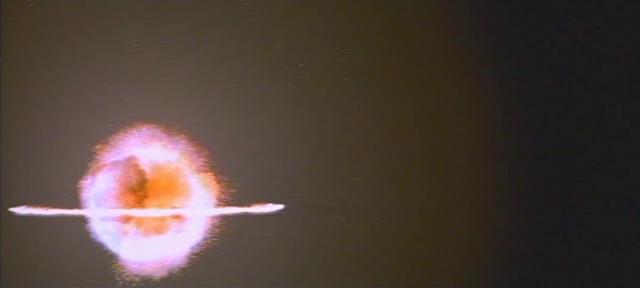
Frame 10
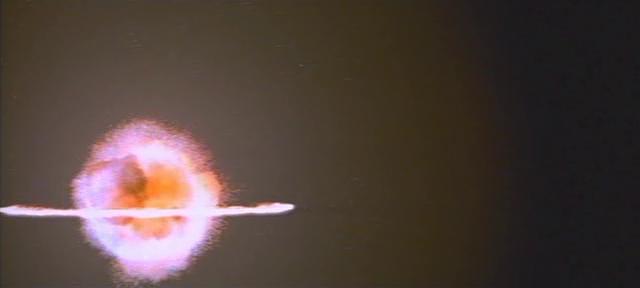
Frame 11
According to you: "It is only when the leftmost section of the ring almost
leaves the frame that the band of brightness seems to reach the
leftmost horizon of the planet."
This is not accurate. The comments you quote above associate with Frame Nine. By Frame Eleven, the leftmost section of the ring has *already* left the frame, not "almost".
You go on to conclude that the far side of the planet was basically untouched until this point!
I draw no such conclusion on my page. Instead, immediately after the sentence you quote above, I state: "Our view of whatever might remain of the planet is obscured by the mysterious ring and the expanding debris."
However, I do not consider the conclusion that the far side of the planet had a relatively stable surface to be improper, given that we do not see surface destruction on a grand scale occurring until the band passes over/through. Prior to the passing of the band, the surface appears stable. Hence my use of the term "destructive band" in prior discussions.
However, when we superimpose the colour-inverted planet on the frame, we get:
... something irrelevant, since the association of text and frame is in error.
Again, I must ask if you have some kind of vision problem.
(Sigh) Concession accepted, again. Carrying on . . .

Frame 27
Secondary burst begins (you can see that the initial burst is slightly up and
to the left, although it is difficult to discern what's going on
through the light and debris).
Note: I disagree with the placement of Frame 27 as the beginning of the secondary explosion. The first visible sign should occur at Frame 23, assuming your present version and the DeathStar-SE.avi from your page are paced the same.
Further, in the process of watching DeathStar-SE.avi frame-by-frame in that section to determine the proper start point, I have noticed something very unexpected and very unusual which no one else seems to have noticed before. In fact, it is so unexpected and unusual that I may need to revise the admittedly-limited theoretical background of the Superlaser Effect theory to account for it.

http://ocean.otr.usm.edu/~randers2/DeathStar-SE-Polar.jpg
The above is a series of cropped screencaps of the northern polar region of Alderaan. The frames are numbered in the pic according to the frame numbering in DeathStar-SE.avi, but on the version you've been using, DS-SE frame 68 should equal Frame Two.
Make note, if you will, that "Santa survives", at least temporarily. There is a planetary surface remaining in the polar region at least until shortly before the secondary explosion. The last frame, 93, is a frame or two before your screencap Frame 27 above.
In the frame marked 68, we see the northern polar region just as the superlaser is striking near the equator. In 72, we see the pole partially obscured by the band which is approaching it. In 77, the band is over the polar region, the surface of which is partially obscured by the dark funk over on the left, and quite obscured by the bright band. In 82 you get to see how the band finally becomes obscured by the polar surface as it rounds the pole.
The polar surface is still visible in 87, albeit even more obscured by funk. In 91, a firey cloud begins to obscure the polar surface on the right, just as the funk obscures it on th eleft, but it is still visible even into the frame marked 93.
I confess to being excited. I thought I'd seen everything there was to see in the clip, but here's new information all of the sudden, yet another piece of data about Alderaan's destruction that no one else has noticed. "Vision problem", my butt.
In regards to DET arguments, several revisions would seem to be in order. Most notably, the claim that the band is merely the entire planet glowing and expanding, "white-hot matter shooting into space", makes no sense. I think all DET theorists are left with as an option to explain the bands is total atmosphere burn-off, but since the superlaser couldn't have deposited more than 23.5 gigatons of energy into the atmosphere as mentioned previously, it sounds like you need an energy increase to begin at the surface upon superlaser impact. Sort of a "superlaser effect", if you will. Also, with the left side and now the polar surfaces remaining visibly intact for so long after the termination of the beam, I think it very difficult for DET theorists to maintain their argument. After all, the superlaser beam actually did very little when it struck the planet . . . but it is readily apparent that something else happened afterward.
Of course, any DET theory at this point, as before, is an exercise in ad hoc rationalizations.
For the Superlaser Effect theory, the new facts will require some sort of revision of some of my earlier hypotheses, which were based on the previously available data. I'm not quite sure what to make of things . . . there may be a similarity with DSCalamari.mpg frames 228 and 229:
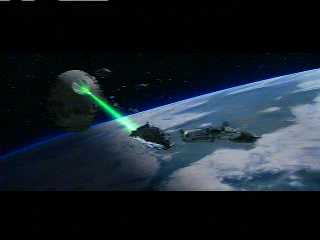
http://ocean.otr.usm.edu/~randers2/DSCalamari228.jpg
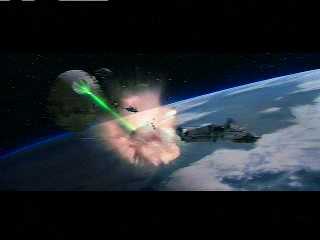
http://ocean.otr.usm.edu/~randers2/DSCalamari229.jpg
...where the superlaser hits the Wingless and, though the ship's outline is still visible in the frame, it is absolutely engulfed with a quick, gassy-looking puff that expands and dissipates rapidly, while the ship's actual exploding process occurs in a much smaller area.
(Also, I had already planned to point out the possible connection between the secondary blast of Alderaan and the secondary blast which finally wiped out the Liberty after her long, slow primary explosion. Frames 127 and 128 of the DSCalamari clip show the immediately before and immediately after the secondary blast:
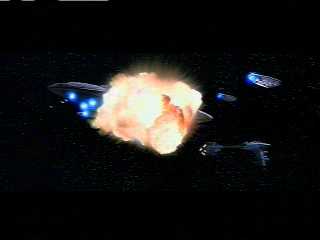
http://ocean.otr.usm.edu/~randers2/DSCalamari127.jpg
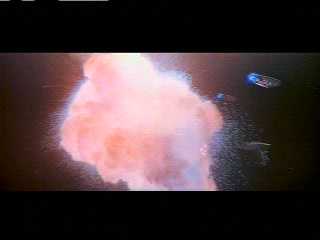
http://ocean.otr.usm.edu/~randers2/DSCalamari128.jpg
In short, the main problem would seem to be that the bands are not as destructive as I thought. With the surface obscured and the debris flying every-which-way, it wasn't too much to conclude that the surface of the planet was so much debris, with that matter being converted into the energy source for the bands. But, this may be contrary to that.
Alternately, they're just as destructive as I thought, the "surface" that is still visible is merely mantle of some sort, with the upper layers having been consumed. I'll have to go back and look at some of the alternatives I had previously considered but discarded due to insufficient data.
Anyway, there's still enough to go on at the moment to deal with the rest of your claims, so . . .
Note that the fire ring has slowed down dramatically. After expanding at a rate of more than 1/3 c between frames 5 and 6, it has covered only 22,000 km in the 21 frames since then, for an average velocity of only 25,000 km/s. This indicates that it is SLOWING DOWN despite the lack of a natural braking mechanism in space!
Which suggests that they are not vaporized ejecta, unless gravity took steroids that day. But, I'll come back to that.
It would be a gross understatement to say that the fire rings are a curious phenomenon.
Yes, and they are impossible phenomena for DET to explain. Several theories . . . indeed, several main theories and perhaps two dozen variations . . . have been put forward to explain the rings. The frontruners (from what I have been able to tell . . . feel free to add more) are:
1. Alderaan shield failure.
1a. Alderaan shield
generator overload and destruct.
2. Alderaan hypermatter reactors
overloading.
3. A blast wave of vaporized material, ordered into a
planar ring by magnetic fields or the planet's rotational energies.
Now, two approaches to counterarguments, regarding each particular theory about the rings:
A. Alderaan-specific counterarguments:
1. No shield has been observed. Further, the starship
examples provide further evidence that not only is their no evidence
for a shield, but there is evidence against a shield. Finally, your
own argument suggests that shield failure occurred one frame prior to
ring formation.
1a. See above.
2. This may explain the origin
of Ring One, but not the position . . . the ring's center is the
center of the planet. Further, it does not explain Ring Two. Finally,
hypermatter is not canon.
3. Does not explain the position of Ring
One, nor its origin, since this would require vaporized material to
magically encircle the globe, and then depart the surface at
significant fractions of lightspeed, carrying (assuming it is a
millionth of the mass of Alderaan) no less than 11% of the rotational
KE from the planet, instantaneous acceleration to .3c
notwithstanding. Further, they apparently aren't vaporized material,
judging by the slow-down you mentioned.
B. All-Ring-specific counterarguments:
1. The DS2 had no shield upon its destruction, and yet
still produced a ring.
1a. see above
2. Hypermatter is not
canon, but even if we allow for it the DS2 explosion and
ring-formation would seem to disprove it, given that the explosion
was not centered at the center of the Death Star II, where the
reactor was, but was instead centered on the DS2's center of mass.
3.
It is unlikely the DS1 was engaging in rotation . . . they were
prepared to fire. DS2 may or may not have been rotating, depending on
your opinion of the Jerjerrod story from the novel fitting into the
movie.
Also, just as a general concept, note the fact that the DET-Alderaan theory has absolutely nothing to offer in regards to the Death Star rings. It is yet another weakness of the DET theory.
Of course, you didn't notice that, but you DID have enough time to say "This secondary explosion is apparently much larger than the first, though it doesn't appear as bright in the first moments (it may have on the opposite side of the planet). It appears to be centered somewhere behind the core of the planet. The second ring is also larger and much faster than the first. The secondary explosion also gives us our first observation of large debris material, appearing to come from the former location of the center of the planet, headed in the general direction the superlaser had come from." <snipe snipped> If the second explosion is off-centre, why does its fire ring line up with the first one?
Probably the same reason the first one lined up the way it did, even though the superlaser did not strike the center of the world, but the surface.
And where is this debris heading TOWARD the Death Star that you describe?
They . . . or, more properly, the first one . . . appears in frame 103 of DeathStar-SE.avi, which should translate into frame 35 of your variant. I'm referring to those bigger dark masses of material. Several are visible both above and below the ring seven frames later, hence my use of the term "general direction".
Example: http://ocean.otr.usm.edu/~randers2/blind.jpg
http://ocean.otr.usm.edu/~randers2/blind.jpg
The next few frames clearly show an explosion that is skewed to the LEFT, not the right:
I didn't say it skewed to the right, now did I . . . so, why the emphasis?
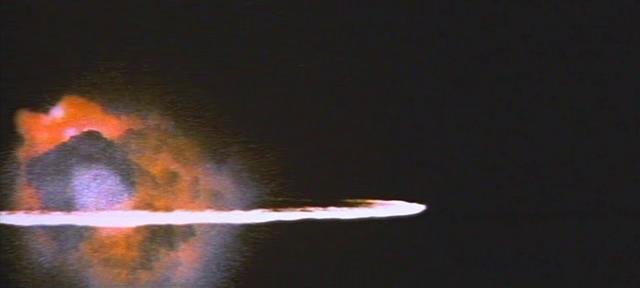
Frame 28
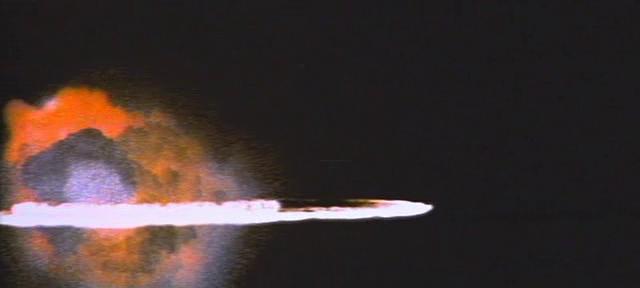
Frame 29
Second "fire ring" appears. Note that it matches the first one in
both location and alignment, thus indicating that despite the
irregular appearance of the "secondary burst", it is still
roughly centred on the planet's original core location.
And in the region of the center of mass, as with the DS2. But, then, it is rather difficult to precisely determine the position of odd, irregular, luminescent, 500km-deep ring sections.
<snip> "This suggests that the superlaser only directly destroyed the part of the planet facing it in those first few milliseconds, since there would be no particular reason for a higher concentration of bulk material (from the core or otherwise) to head toward the original location of the beam.
And, as can be observed by the continued existence of the left side and the pole, I was correct.
It would have to be either because that area of the planet no longer existed (providing no resistance), and/or because something (the secondary explosion, produced somehow by the bands) was giving it a good shove from behind. This also serves to explain why so much of the material of the secondary explosion seemed to fly away and behind the planet, while larger pieces flew forward."
However, since the explosion does NOT hurl any more material back toward the Death Star than it does in any other direction,
Did you see bulk material flying every which way? Didn't think so. All we see is that which heads in the general direction of the Death Star. Sure, there's probably *more* material flying backward (as I said), but the larger pieces flew forward (as I said).
your "observation" turns out to be a fabrication, along with any conclusions reliant upon it.
It is taking a bit of effort to maintain self-restraint against such petty attacks, but not a great amount. Self-control: use it.
Are you willing to concede that you have either misrepresented the evidence or seen an extremely poor-quality copy of it?
I have not misrepresented the evidence, and the only "extremely poor-quality copy" of it that I have is the one I downloaded from your site, and which you earlier admitted to creating.
I have presented clear evidence that the entire planet is ALREADY expanding in frame 5,
Where "entire" does not equal "left side, north pole, etc."
its asymmetry is actually skewed AWAY from the superlaser and not toward it as you say,
Clear evidence, clearly observed from "two-dimensional thinking".
there is NOT an unusual concentration of debris heading back toward the Death Star,
Except for all that dark bulk material I was referring to . . .
the "dark spot" is NOT located at the superlaser contact point,
Not dead-center, but not so far away as to present a problem.
and the two explosions are NOT significantly off-centre from one another.
What?
<snip> If you are willing to concede that your observations are faulty, we can move onto your "fire ring" fallacies in our next exchange
My observations *were* faulty . . . I failed to notice the polar region. Besides that little bawble, however, my observations are spot-on. I'll be looking into the surviving-surface evidence, and will be revising my theory accordingly, if required. You and your associates can go gang up on trying to keep the DET theory, and revising the claims about the evidence accordingly.
You may also wish to prepare yourself for the attack on DET from the Principle of Parsimony. I do not know what valid defense can be employed by DET theorists, but I'll be curious to see what is attempted.
DarkStar
